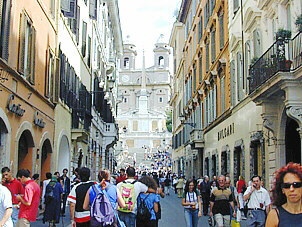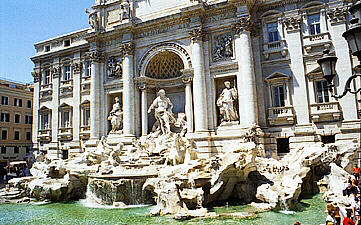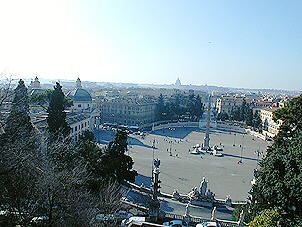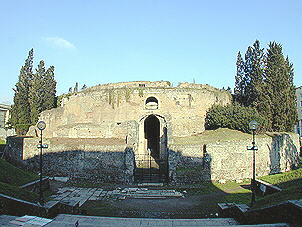
Rome GuideSPANISH STEPS - TREVI FOUNTAINFor a complete presentation, please visit the specific pages on the streets of the quarter:
Rome visitors never cease to be delighted and surprised by Piazza di Spagna. It owes its name to the Spanish Embassy, the first to be permanently established in Rome, in Palazzo Spagna by Antonio del Grande (1647). The square was completed with the building of the Spanish Steps (Scalinata di Trinita’ dei Monti) in 1725. Designed by the Italian architect Francesco De Santis, the project was financed by King Louis XV of France. The striking architecture of the area was designed by Pope Sixtus
V, a renowned town planner of the time. Through the centuries, millions
of visitors have walked the Spanish Steps and admired their timeless
beauty.
|
APARTMENTS FOR RENT IN THIS QUARTER"Leonardo" (Via della Croce), a three bedroom, sitting room, 2 bathrooms, terrace apartment in an 18th century palazzo (2-8 persons) "Valentino" (Via Sistina, Piazza Trinita' dei Monti): elegant one bedroom, sitting room, dining room, studio room, 2 bathrooms, kitchen apartment with large patio and large terrace with stunning panoramic views of all Rome (2-3 persons). "Regina" (Via San Giacomo): deluxe three bedroom, sitting room, dining room, terrace with garden apt.. Three bathrooms (5-6 persons). Possibly available also its adjoining annex (French "dependence") with bedroom/bathroom. "Contessa" (Via dei Greci): an elegant two bedroom, sitting room, dining room apt. with two bathrooms, kitchen and balconies. |
|||||||||||||||||||||
Spanish StepsThe Spanish Steps consist of 12 flights of travertine steps of varying widths, leading up to the Church of Trinità dei Monti. Every year, in May, the steps are decorated with pink azaleas, making this month a delightful time to visit. While most visitors enjoy climbing the steps, for those who prefer an easier route up, there is a lift/elevator outside of the metro station. In the piazza at the bottom of the Spanish Steps is the 17th century Fountain of the Old Boat (Fontana della Barcaccia), spouting water as she sinks. This fountain, by Pietro Bernini, supposedly marks the place where a large barge came to rest when the River Tiber overflowed its banks. In the 18th and early 19th centuries, the area surrounding and including the Spanish Steps became a popular visiting point for wealthy people making the Grand Tour of Europe. All rich foreign travellers were given honorary British citizenship and treated as noble folk. This made it easy for locals to make money from them by offering their services. The term er ghetto de l’inglesi—literally, “the English ghetto”—was the name given to this area at the time, referring both to the wealthy English who made the area their home as well to the penniless English artists and writers. Church of Trinità dei MontiAt the end of the steps you find the scenic Franciscan Church of Trinità dei Monti, by architects Carlo Maderno and Domenico Fontana, with in front the Sallustian Obelisk, taken from the ancient Sallustian Gardens.John Keats and Percy B. Shelley lived in the palazzo to the right of the Steps, and their home is presently a memorial museum. Via Condotti
For lovers of fashion, Via Condotti is no disappointment! Valentino, Bulgari, Gianni Versace, Salvatore Ferragamo, Cartier, Dolce & Gabbana, Chanel, Fendi and Jean-Paul Gauthier are just a few of the designer boutiques to be found here. Trevi Fountain
Legend has it that throwing a coin into the Trevi fountain will ensure your return to Rome. (It is important that you do so by turning away from the fountain and tossing the coin over your shoulder.) Via del Babuino
Piazza del Popolo
Just above the Piazza is the Pincio Garden, one of the oldest parts of the renowned Borghese Gardens. From here, you have the best views of Rome at sunset. The garden is separated from the gardens of the Villa Borghese by ancient walls, and consists of a number of formal, tree-lined avenues. Palace for the Defense of the Holy FaithIn this quarter you will also find the Spanish Embassy (after which the Steps and Piazza are named). You will also find Francesco Borromini’s Palace for the Defense of the Holy Faith (Palazzo di Propaganda Fide) and, perhaps surprisingly, a MacDonald’s. This fast food emporium is quite unlike any other! Its elegant interior has replica frescoes, and is preceded by a Roman mosaic at the entrance. It is worth noting that MacDonald’s houses the only washrooms in the area. On Via della Mercede you will find the home of Borromini’s great rival, Gianlorenzo Bernini. Adjacent to Bernini’s home is the charming church of Sant'Andrea delle Fratte. Mausoleum of Augustus
|
||||||||||||||||||||||





